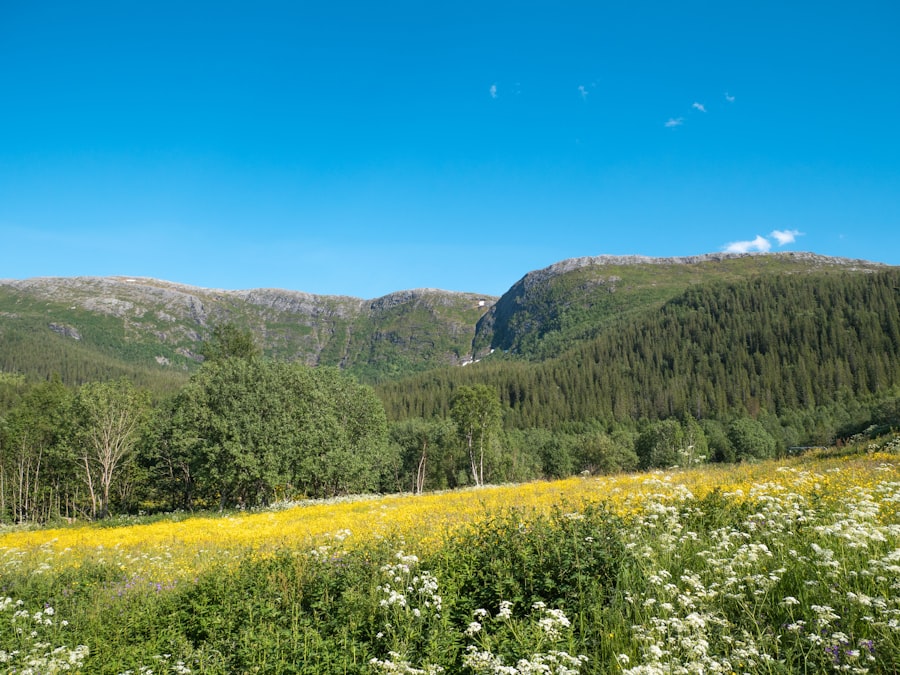Norwegian cuisine is a reflection of the country’s rich cultural heritage and its close relationship with nature. Rooted in the traditions of the indigenous Sami people and influenced by centuries of trade and migration, the culinary landscape of Norway is as diverse as its breathtaking landscapes. From the rugged fjords to the expansive forests, the ingredients that define Norwegian cooking are often sourced from the land and sea, showcasing a deep respect for the environment and a commitment to sustainability.
At its core, traditional Norwegian cuisine is characterised by simplicity and a focus on high-quality ingredients. The dishes are often hearty and nourishing, designed to sustain the body through the long, cold winters. While modern influences have begun to permeate the culinary scene, many traditional recipes have been preserved, passed down through generations, and continue to be celebrated in homes and restaurants across the country.
This article will delve into the various aspects of Norwegian cuisine, exploring its ingredients, techniques, and cultural significance. Book Your 1-Hour Relocation Strategy Session
Summary
- Traditional Norwegian cuisine is heavily influenced by the country’s natural resources and climate, resulting in a focus on fish, dairy, and hearty breads and pastries.
- Fish, particularly salmon, herring, and cod, plays a central role in Norwegian cuisine, with various traditional preparation methods such as smoking and pickling.
- Traditional Norwegian ingredients include potatoes, root vegetables, berries, and wild game, reflecting the availability of produce in the country’s diverse landscapes.
- The influence of nature on Norwegian cuisine is evident in the use of foraged ingredients such as mushrooms, herbs, and seaweed, as well as the emphasis on preserving and fermenting foods.
- Traditional Norwegian cooking techniques include methods such as boiling, steaming, and baking, often used to create comforting and hearty dishes.
The Importance of Fish in Norwegian Cuisine
Fish holds a central place in Norwegian cuisine, reflecting the country’s extensive coastline and rich maritime heritage. With over 25,000 kilometres of coastline, Norway is blessed with an abundance of fish species, making it a staple in the diet of its people. Cod, herring, salmon, and mackerel are just a few examples of the fish that are commonly consumed, often prepared in ways that highlight their natural flavours.
The significance of fish extends beyond mere sustenance; it is deeply woven into the cultural fabric of Norway. Traditional methods of preservation, such as drying and smoking, have been employed for centuries to ensure that fish could be stored for long periods, especially during the harsh winters. Dishes like klippfisk (dried and salted cod) and rakfisk (fermented fish) are not only culinary delights but also represent a connection to Norway’s history and traditions.
The importance of fish in Norwegian cuisine is further underscored by its role in festive occasions, where it often takes centre stage on the dining table.
Exploring Traditional Norwegian Ingredients

Norwegian cuisine is characterised by its use of fresh, local ingredients that reflect the country’s diverse geography. Root vegetables such as potatoes, carrots, and turnips are staples in many traditional dishes, providing essential nutrients and heartiness. Berries, foraged from the wild, such as cloudberries and lingonberries, add a touch of sweetness and tartness to both sweet and savoury dishes alike.
In addition to vegetables and berries, Norway’s unique climate allows for the cultivation of specific herbs and grains that are integral to its culinary identity. Dill, parsley, and chives are commonly used to enhance flavours, while barley and oats serve as foundational grains in various recipes. The emphasis on seasonal ingredients not only promotes sustainability but also ensures that each dish is imbued with the essence of Norway’s natural bounty.
The Influence of Nature on Norwegian Cuisine
The stunning landscapes of Norway have a profound impact on its culinary traditions. The rugged mountains, deep fjords, and expansive forests provide an abundance of resources that shape what is available for consumption. This close relationship with nature fosters a deep appreciation for local produce and encourages a farm-to-table ethos that is increasingly relevant in today’s culinary world.
Seasonality plays a crucial role in Norwegian cooking; dishes often change with the seasons as different ingredients come into their prime. For instance, during summer months, fresh herbs and vegetables dominate menus, while winter brings hearty stews and preserved foods to the forefront. This cyclical approach not only reflects the natural rhythms of life in Norway but also highlights the importance of sustainability and respect for the environment in traditional Norwegian cuisine.
Traditional Norwegian Cooking Techniques
Traditional Norwegian cooking techniques are rooted in practicality and resourcefulness, developed over centuries to make the most of available ingredients. One such technique is slow cooking, which allows flavours to meld together while ensuring that tougher cuts of meat become tender and succulent. Stews like fårikål (lamb and cabbage stew) exemplify this method, showcasing how simple ingredients can create deeply satisfying meals.
Preservation methods also play a significant role in Norwegian cooking. Techniques such as smoking, curing, and fermenting have been used for generations to extend the shelf life of fish and meats. These methods not only enhance flavours but also contribute to the unique character of traditional dishes.
For example, lutefisk (dried fish reconstituted in lye) is a dish that embodies this preservation technique and is often served during festive occasions.
Regional Variations in Norwegian Cuisine

Norwegian cuisine is not monolithic; it varies significantly from region to region, influenced by local resources and cultural practices. In coastal areas, seafood takes precedence, with dishes featuring fresh catches prepared in various ways. The northern regions are known for their reliance on game meats such as reindeer and elk, reflecting the indigenous Sami culture’s connection to the land.
Inland areas often focus on hearty fare that utilises root vegetables and grains, while southern regions may incorporate more dairy products into their cooking. Each region boasts its own specialities; for instance, Bergen is famous for its fish soup, while Telemark is known for its rich cheeses. These regional variations not only enrich the culinary landscape but also tell stories about the people who inhabit these diverse areas.
The Role of Dairy in Norwegian Cuisine
Dairy products hold a prominent place in traditional Norwegian cuisine, with cheese being particularly celebrated. Brown cheese (brunost), made from whey and caramelised milk solids, is a beloved staple that adds a unique sweetness to both sweet and savoury dishes. It is often enjoyed on crispbread or paired with fruit for breakfast or as a snack.
In addition to cheese, other dairy products such as sour cream and buttermilk are frequently used in cooking and baking. They add richness and depth to dishes like rømmegrøt (a creamy porridge) or are used as accompaniments to various meats. The use of dairy reflects Norway’s agricultural heritage and highlights the importance of local farming practices in shaping traditional recipes.
Traditional Norwegian Breads and Pastries
Bread holds a special place in Norwegian culture, often serving as an essential component of daily meals. Traditional breads are typically dense and hearty, made from whole grains such as rye or barley. Flatbreads like lefse are particularly popular; these thin, soft breads can be served with various toppings or used as wraps for meats and cheeses.
Pastries also play a significant role in Norwegian cuisine, especially during festive occasions. Kransekake (a ring cake made from almond flour) is a traditional dessert served at weddings and celebrations, while skolebrød (school bread) is a beloved treat filled with custard and topped with coconut flakes. These baked goods not only satisfy sweet cravings but also embody the warmth of Norwegian hospitality.
The Significance of Holidays and Festivals in Norwegian Cuisine
Holidays and festivals are integral to Norwegian culture, with food playing a central role in these celebrations. Christmas (Jul) is perhaps the most significant holiday when families gather to enjoy traditional dishes such as ribbe (roast pork belly) or pinnekjøtt (dried lamb ribs). The festive atmosphere is enhanced by an array of sweets like pepperkaker (gingerbread cookies) that are shared among loved ones.
Midsummer celebrations also feature unique culinary traditions, with dishes highlighting fresh seasonal produce and seafood. These gatherings foster a sense of community and connection to cultural heritage through shared meals that honour age-old recipes passed down through generations.
Modern Innovations in Traditional Norwegian Dishes
While traditional Norwegian cuisine remains deeply rooted in history, contemporary chefs are increasingly experimenting with these age-old recipes to create innovative dishes that resonate with modern palates. By incorporating global flavours or reimagining classic techniques, they breathe new life into traditional fare while maintaining respect for its origins. For instance, chefs may take traditional fish dishes and pair them with unexpected accompaniments or utilise modern cooking methods such as sous-vide to enhance textures without compromising flavour.
This fusion of tradition and innovation not only appeals to younger generations but also showcases Norway’s evolving culinary landscape on an international stage.
Where to Experience Traditional Norwegian Cuisine
For those eager to experience authentic Norwegian cuisine firsthand, there are numerous avenues to explore across the country. Local markets offer an excellent opportunity to sample fresh produce, artisanal cheeses, and cured meats while engaging with passionate vendors who can share stories about their products. Restaurants throughout Norway often feature traditional dishes on their menus, allowing diners to savour regional specialities prepared with care.
Additionally, food festivals celebrate local ingredients and culinary traditions, providing an immersive experience for those looking to delve deeper into Norway’s gastronomic heritage. To truly understand the nuances of traditional Norwegian cuisine, consider booking a One-Hour Strategy Session with the Norway Relocation Group. This session can provide invaluable insights into local dining experiences tailored to your preferences while offering guidance on how best to navigate Norway’s vibrant food scene.
Whether you’re relocating or simply visiting, this personalised approach will enhance your culinary journey through this beautiful country.

